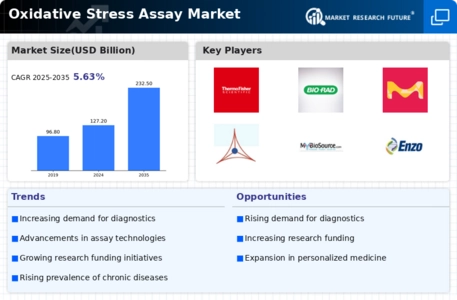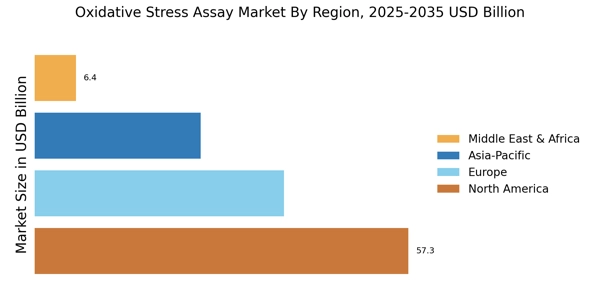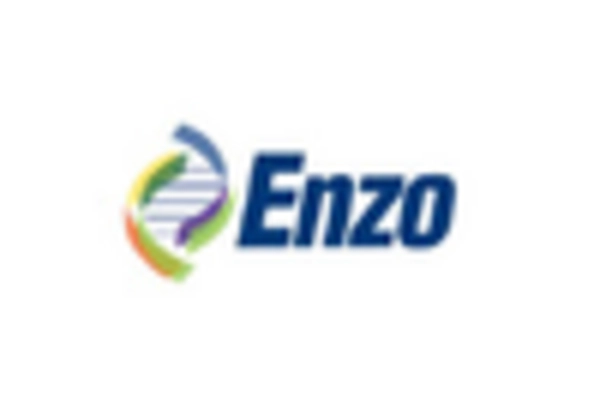Advancements in Assay Technologies
Technological innovations in assay methodologies are significantly influencing the Oxidative Stress Assay Market. The development of more sensitive and specific assays, such as high-throughput screening techniques and advanced spectroscopic methods, indicates a shift towards more efficient testing. These advancements not only improve the accuracy of oxidative stress measurements but also reduce the time required for analysis. Market data suggests that the introduction of novel assay platforms is expected to enhance the overall market landscape, attracting both researchers and clinicians. As these technologies evolve, they may provide deeper insights into oxidative stress mechanisms, further driving research and clinical applications. Consequently, the ongoing evolution of assay technologies is likely to play a crucial role in shaping the future of the oxidative stress assay market.
Growing Awareness of Oxidative Stress
There is a notable increase in awareness regarding the role of oxidative stress in various health conditions, which is driving the Oxidative Stress Assay Market. Educational initiatives and public health campaigns are emphasizing the importance of oxidative stress in disease prevention and management. This heightened awareness is likely to lead to increased testing and monitoring, as individuals and healthcare providers seek to understand the oxidative status of patients. Market analysis indicates that as more people become informed about the implications of oxidative stress, the demand for related assays will grow. This trend suggests a potential shift in healthcare practices, where oxidative stress assessments may become a standard component of routine health evaluations, thereby expanding the market.
Increasing Prevalence of Chronic Diseases
The rising incidence of chronic diseases such as diabetes, cardiovascular disorders, and neurodegenerative conditions appears to be a primary driver for the Oxidative Stress Assay Market. These diseases are often linked to oxidative stress, prompting healthcare providers and researchers to seek reliable assays for early detection and monitoring. According to recent data, oxidative stress is implicated in the pathophysiology of these conditions, leading to a heightened demand for assays that can quantify oxidative damage. This trend suggests that as the burden of chronic diseases escalates, the need for oxidative stress assays will likely increase, thereby propelling market growth. Furthermore, the integration of these assays into routine clinical practice may enhance patient outcomes by facilitating timely interventions.
Rising Investment in Research and Development
The surge in investment directed towards research and development in the field of oxidative stress is a significant driver for the Oxidative Stress Assay Market. Funding from both public and private sectors is increasingly being allocated to studies exploring the implications of oxidative stress in various diseases. This influx of capital is likely to facilitate the development of innovative assays and enhance existing methodologies. Data indicates that research initiatives focusing on oxidative stress are expanding, which may lead to the discovery of novel biomarkers and therapeutic targets. As the research landscape evolves, the demand for reliable oxidative stress assays is expected to rise, further propelling market growth. This trend underscores the importance of R&D in shaping the future of the oxidative stress assay market.
Integration of Assays in Personalized Medicine
The integration of oxidative stress assays into personalized medicine frameworks is emerging as a key driver for the Oxidative Stress Assay Market. As healthcare shifts towards more individualized treatment approaches, the ability to assess oxidative stress levels in patients can provide valuable insights for tailored therapies. This trend suggests that oxidative stress assays may play a pivotal role in optimizing treatment regimens based on a patient's unique oxidative profile. Market data indicates that personalized medicine is gaining traction, with an increasing number of healthcare providers recognizing the importance of oxidative stress in treatment decisions. Consequently, the incorporation of these assays into personalized medicine strategies is likely to enhance their demand, thereby contributing to the growth of the oxidative stress assay market.


















Leave a Comment